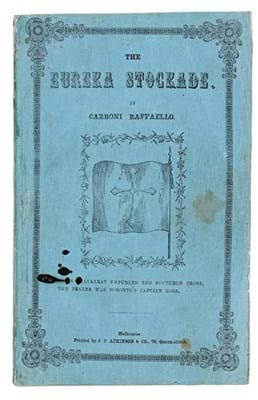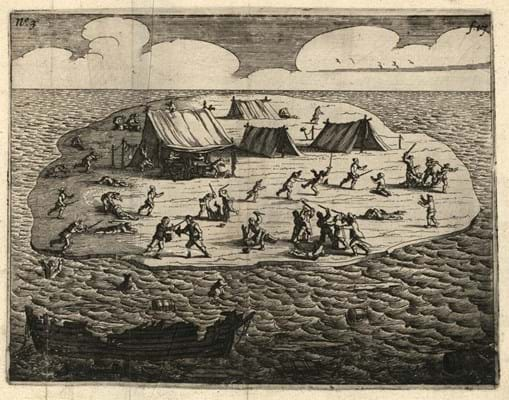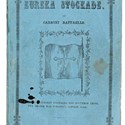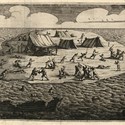A rare first-hand account of the Eureka Rebellion, a revolt by Australian gold miners against licence fees and other injustices, was a highlight of an Australian Book Auctions (19.8% buyer’s premium) sale of August 21-22.
The copy of The Eureka Stockade… pictured above sold at a record Aus$40,000 (£24,390).
Twenty-two miners and five troopers died in what was the culminating clash of a period of civil disobedience in the Ballarat region during the Victorian gold rush.
When the uprising had been put down by the Gold Commission’s police force and other troops, 13 of the miners’ leaders were taken to Melbourne for trial.
Public support and unrest this prompted helped bring about an acquittal, however, and the 1855 introduction of an electoral act mandating full (white) male suffrage for the lower house in the Victoria parliament – only the second instituted act of political democracy in Australia.
Statements by the rebellion’s leaders had appeared in the Melbourne newspapers early in 1855, but it was only at the year’s end, as the first anniversary of the ‘battle’ loomed, that The Eureka Stockade…, by Raffaello Carboni, one of those who had taken a leading part, was published.
Carboni, an Italian nationalist who had lived in self-imposed exile in London before sailing for the Ballarat goldfields in 1853, was an experienced revolutionary. A respected member of the European community at the diggings, he was made a member of the miners’ central committee and given responsibility for organising the foreigners in the stockade.
Carboni had been one of those charged with high treason, even though he had been a helpless spectator when the actual fighting occurred and was arrested while tending to the injured and dying.
He and the others were tried but no jury would convict them, and on acquittal Carboni was borne away in triumph by the crowd.
Recognised as one of the more reliable records of events and the underlying causes, Carboni’s account was printed in Melbourne at his own expense and sold at the site of the massacre on the first anniversary. However, just a few weeks later he returned to Italy to join the Risorgimento.
Described by the cataloguer as “perhaps the most idiosyncratic and robustly eccentric work of Australian historical and political literature, vigorously enlivened by humour and invective…”, it was also promoted as “perhaps the finest copy, and nicely associated at that, which we have seen on the market in decades”.
In original wrappers, it had belonged to the work’s printer, James Atkinson, and contained two related letters.
Botany Bay blues
Sold for Aus$38,000 (£23,170), and equalling a record set in the same rooms in 2005 for the copy in the superb Davidson library, was another great rarity: a 1794 first (in later half calf) of George Thompson’s Slavery and Famine, Punishments for Sedition; or, an Account of the Miseries and Starvation at Botany Bay.
“The first independent account of the colony by an eye-witness who was neither an official or a convict”, it is based on the journal of a gunner on the Royal Admiral, an East Indiaman that two years earlier had sailed for New South Wales with 336 convicts aboard. Thompson was in charge of the prisoners and their provisions.
Thompson’s experiences came to the attention of Thomas Fyshe Palmer, a Scottish political reformer who obtained his permission to edit and publish his journal, together with an introductory essay. This first issue contained a dedication to the Quakers that was felt by many to be too harsh and in most copies either altered or removed.
Shipwreck horror
A famous early work on the discovery of Australia is Francois Pelsaert’s Ongeluckige Voyagie Van’t Schip Batavia nae de Ost-Indien. Published in Amsterdam in 1647, it is an account of the wreck of the Batavia on the western coast of Australia.
Carrying some 300 would-be settlers, merchants and their servants, the Batavia came to grief on Houtmans Abrolhos, a chain of more than a hundred islands and coral reefs.
Pelsaert landed 180 survivors on one large island and 40 on another smaller island before leaving 70 crew members on the wreck. He and a small crew then left in the ship’s boat on an epic journey to seek help.
On his return he found that some of the crew had mutinied, killed all the men on the small island, along with those on the larger island who would not join them, and raped and virtually enslaved the women.
Pelsaert and his new crew captured, tortured and tried the mutineers before hanging seven of their leaders. The rest were taken for execution in Batavia, but in marooning two of them on the coast he provided a model for a later British tradition of dumping unwanted criminals on Australian shores.
A copy offered on May 31 by Bubb Kuyper (20% buyer’s premium) in Haarlem, Netherlands, had many shortcomings – close trimming or fraying to the outer margins, waterstains throughout and tears, spotting or soiling to the plates, and so on – but its rarity pushed it to €65,000 (£56,520).
Only one other copy is recorded at auction: in the 2005 ABA sale of the first portion of the Davidson library. Again in half morocco, and with the title supplied from another copy, it had the distinct advantage of being the first copy offered at auction in many decades and, in better condition, made Aus$400,000 (then around £160,000).


















